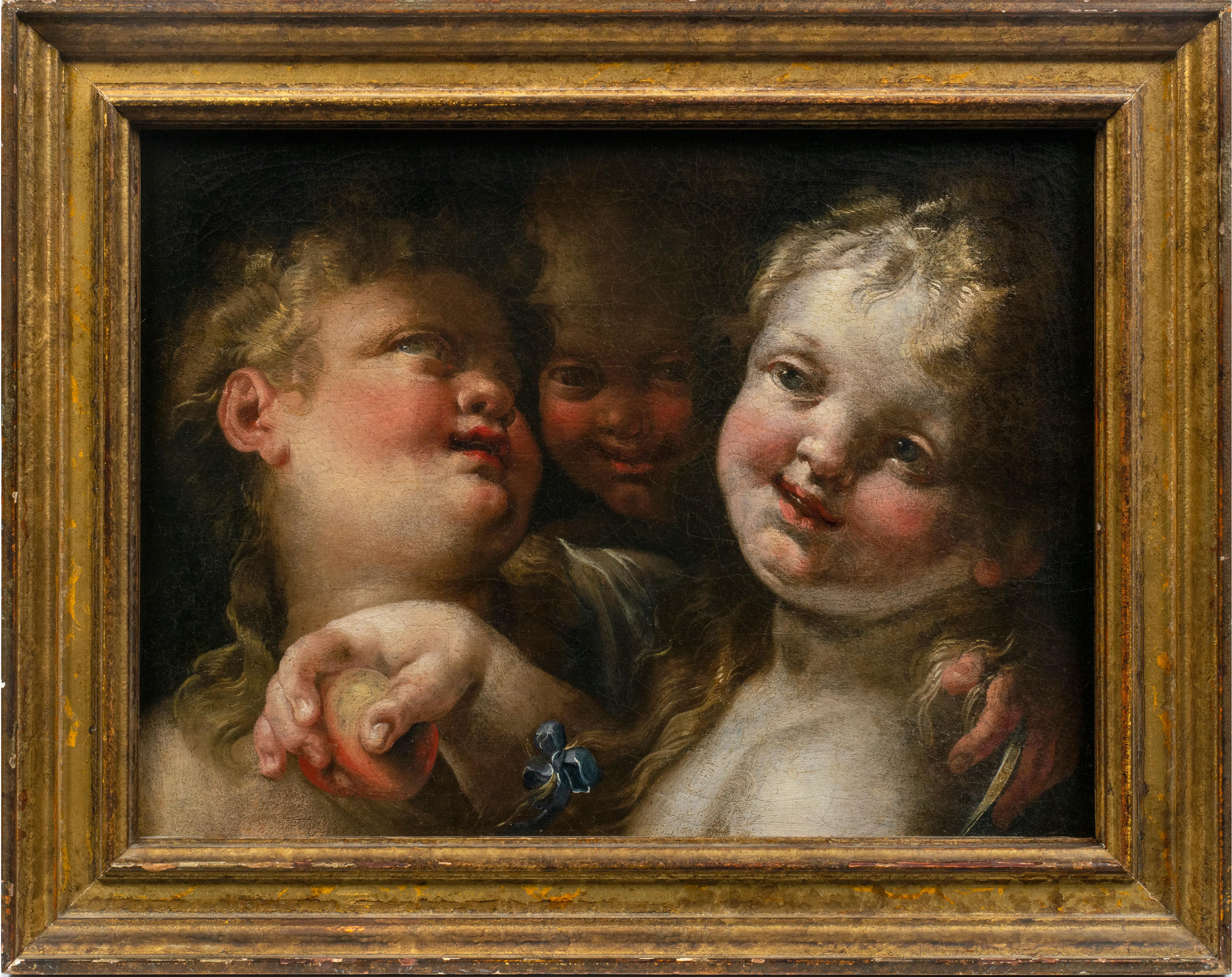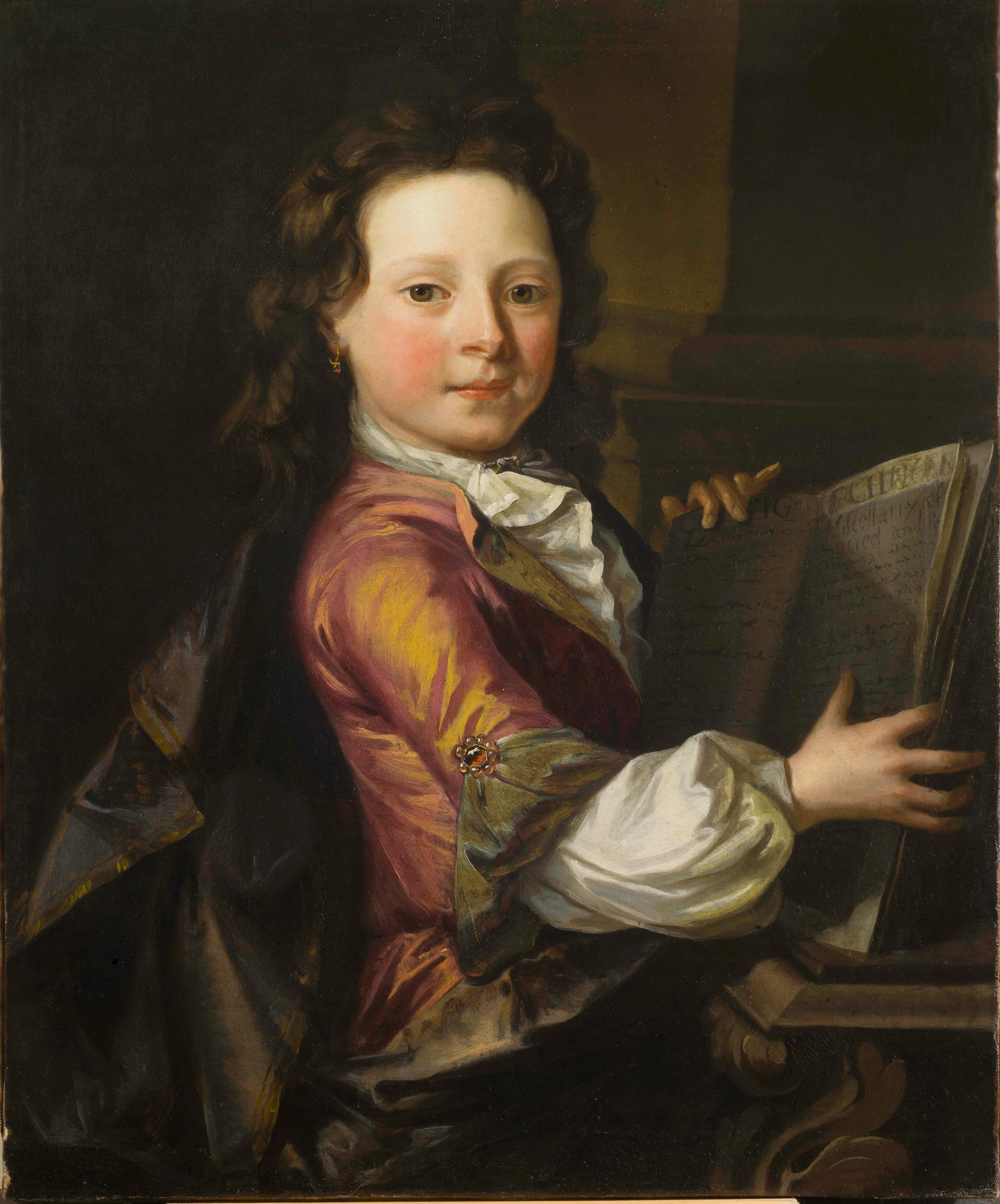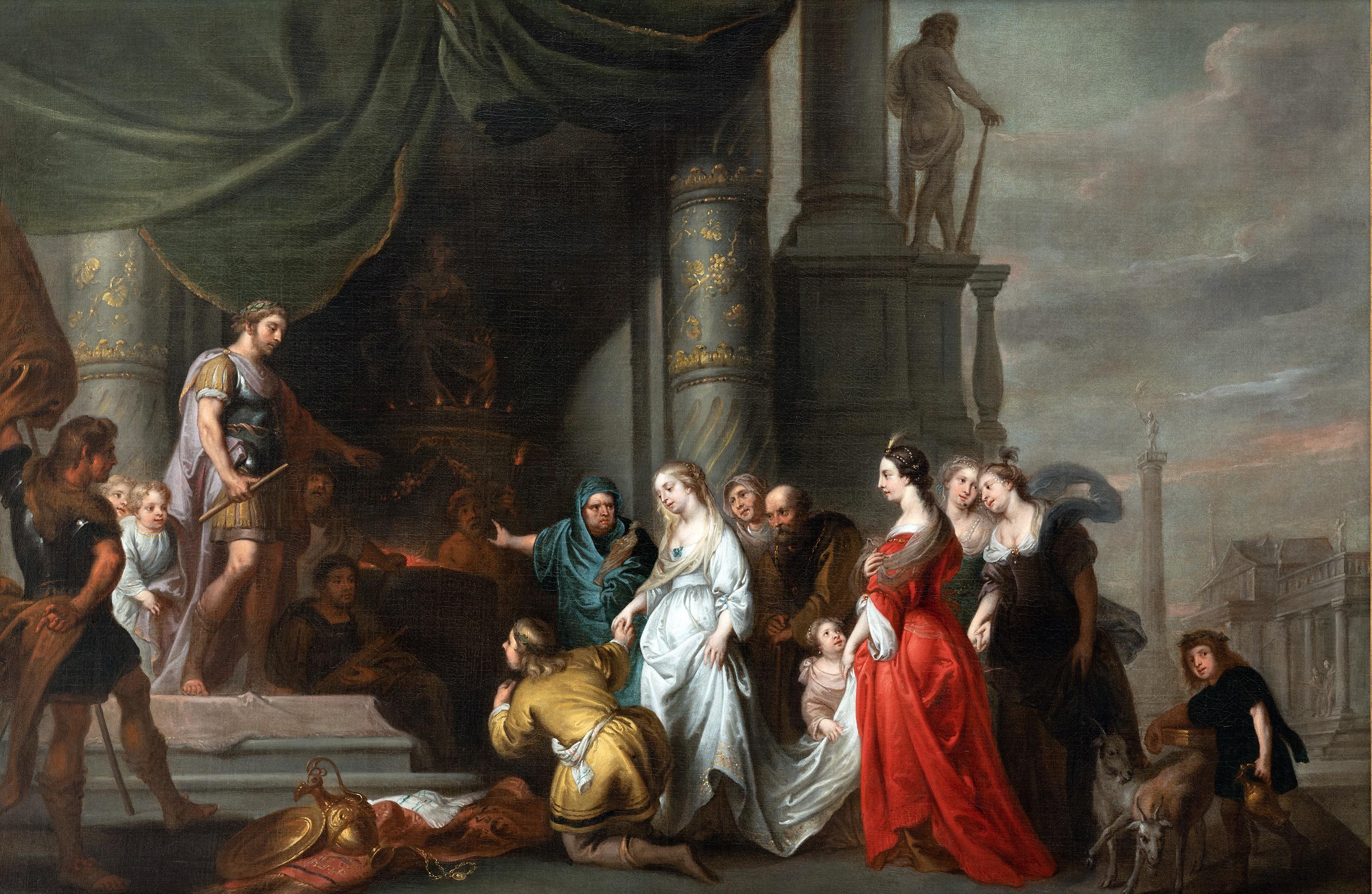Items Similar to PHILOSOPHER - Neapolitan School - Italian- Figurative Oil on canvas painting
Video Loading
Want more images or videos?
Request additional images or videos from the seller
1 of 12
Ciro De RosaPHILOSOPHER - Neapolitan School - Italian- Figurative Oil on canvas painting2008
2008
About the Item
Philosopher - Ciro De Rosa Italia 2008 - Oil on canvas cm. 60x50
Gold leaf gilded wooden frame available on request
The painting by the painter Ciro De Rosa portrays an old and wise philosopher with a long and white beard and an intense red cloak on an almost black background, giving the work lightness and luminosity. The painter Ciro De Rosa is inspired by a famous artist of the Neapolitan school, Luca Giordano, an Italian Baroque painter, Neapolitan, of the late seventeenth and early eighteenth centuries.
- Creator:Ciro De Rosa (1956, Italian)
- Creation Year:2008
- Dimensions:Height: 23.63 in (60 cm)Width: 19.69 in (50 cm)
- Medium:
- Movement & Style:
- Period:
- Framing:Frame IncludedFraming Options Available
- Condition:
- Gallery Location:Napoli, IT
- Reference Number:1stDibs: LU568310120802
About the Seller
4.8
Vetted Seller
These experienced sellers undergo a comprehensive evaluation by our team of in-house experts.
1stDibs seller since 2017
146 sales on 1stDibs
Typical response time: 1 to 2 days
- ShippingRetrieving quote...Ships From: Napoli, Italy
- Return PolicyA return for this item may be initiated within 14 days of delivery.
More From This SellerView All
- PORTRAIT OF A LADY E.Frattini - English School - Italy Figurative Oil on CanvasBy Ettore FrattiniLocated in Napoli, ITPortrait of a Lady - Ettore Frattini Italia 2005 - Oil on canvas cm.100x70. The painting by Ettore Frattini depicts an elegant and refined noblewoman, the painting is inspired by t...Category
Early 2000s Baroque Portrait Paintings
MaterialsCanvas, Oil
- PHILOSOPHER - Dutch, Flemish, Baroque - Figurative Oil on Canvas PaintingBy Ciro De RosaLocated in Napoli, ITPhilosopher - Ciro De Rosa Italia 2008 - Oil on canvas cm. 26x26 Gold leaf gilded wooden frame available on requestThe evocative portrait of Ciro De Rosa portrays an elderly man with...Category
Early 2000s Baroque Portrait Paintings
MaterialsOil, Canvas
- SPRING BEAUTY - Angelo Granati - Oirtrair of Oil on Canvas PaintingBy Angelo GranatiLocated in Napoli, ITSPRING BEAUTY - Oil on canvas painting by Angelo Granati, Italy 2011 Gold leaf gilded, pleated silk and mirror wooden frame ext. mis. cm. 164x106. This is his reinterpretation of pa...Category
2010s French School Figurative Paintings
MaterialsCanvas, Oil
- LADY'S PORTRAIT - In the Manner of G. Boldini - Italian Oil on Canvas PaintingBy Ciro De RosaLocated in Napoli, ITLady's portrait - Ciro de Rosa Italia 2002 - Oil on canvas cm. 63x47 The painting by Ciro De Rosa portrays a beautiful noblewoman with an elegant and sophisticated dress, he reinterp...Category
Early 2000s Italian School Portrait Paintings
MaterialsOil, Canvas
- LADY'S PORTRAIT - Venetian School - Oil on Canvas Italian Figurative PaintingBy Giovanni SantanielloLocated in Napoli, ITLady's portrait - Giovanni Santaniello Italia 2002 - Oil on canvas cm. 100 x 80 The painting by Giovanni Santaniello depicts a portrait of a beautiful pensive woman in elegant clothe...Category
Early 2000s Italian School Portrait Paintings
MaterialsOil, Canvas
- LADY IN BLACK-In the Manner of G. Bodini Italy figurative oil on canvas paintingBy Eugenio De BlasiLocated in Napoli, ITLADY IN BLACK - Oil on canvas painting, Eugenio De Blasi, Italy, 2011 This is his reinterpretation of a greatest old master painting by Giovanni Boldini. Gold leaf gilded and mohogan...Category
Early 2000s Italian School Figurative Paintings
MaterialsOil, Canvas
You May Also Like
- Portrait of a GentlemanBy Ippolito Scarsella (Scarsellino)Located in New York, NYProvenance: Suida-Manning Collection, New York Private Collection Exhibited: Venetian Paintings of the Sixteenth Century, Finch College Museum of Art, New York, October 30-December 15, 1963, no. 31. Veronese & His Studio in North American Collections, Birmingham Museum of Art, Oct. 1-Nov. 15, 1972, and Montgomery Museum of Fine Arts, Dec. 5-Dec. 31, 1972 Literature: Robert L. Manning, A Loan Exhibition of Venetian Paintings of the Sixteenth Century, exh. cat. New York 1963, cat. no. 31ill., as by Veronese Stephen Clayton and Edward Weeks, eds., introduction by David Rosand, Veronese & His Studio in North American Collections, Birmingham 1972, as by Veronese, p. 38 ill. Terisio Pignatti, Veronese, Venice 1976, I, p. 199, cat. no. A225, II, fig. 908, as attributed to Veronese Terisio Pignatti and Filippo Pedrocco, Veronese; catalogo completo dei dipinti, Florence 1991, no. 54°, as attributed to Veronese. Terisio Pignatti and Filippo Pedrocco, Veronese, Milan 1995, II, pp. 517-518ill., cat. no. A 56, under attributed paintings, by Veronese and workshop) John Garton, Grace and Grandeur; The Portraiture of Paolo Veronese, London-Turnhout 2008, p. 237, fig. 77, cat. no. R16, as workshop of Veronese. Scarsellino’s art is widely regarded as critical link between the Renaissance and the Baroque styles in Emilian painting; not only was he an important transmitter of the heritage of the Renaissance, but he was also open to innovative ideas, and was one of the earliest to experiment with the trend to naturalism that would become fundamental to art of the new century. Born around 1550, he received his earliest training from his father Sigismondo, an architect and painter; it was probably while working at his father’s side as a youth that he acquired the nickname Scarsellino, or “little Scarsella”. After absorbing the principles of his art in Ferrara and Parma, he went to Venice in 1570, staying for four years and working in the shop of Veronese. In the following decade, his art —especially in terms of its piety and its development of landscape— demonstrates a strong sympathy with that of the Carracci, with whom he worked in 1592-1593 at the Palazzo dei Diamanti in Ferrara. Maria Angela Novelli and later Alessandra Frabetti both propose that Scarsellino traveled to Rome, although such a trip has not been documented; if he did travel to Rome, it probably would have occurred during the years that Scarsellino’s colleagues Agostino and Annibale Carracci were there, that is, beginning in 1595 and until 1609. The last decades of Scarsellino’s career again involve stylistic experimentation, this time in a manner that would bring his work very close to the progressive figurative naturalism of Carlo Bononi and prepare the way for Guercino. The present portrait of a distinguished gentleman had been long thought to be by Paolo Veronese and was in fact attributed to him by such distinguished connoisseurs as Adolfo Venturi and Wilhelm Suida. The portrait’s style is, however, distinct from Veronese’s, although clearly indebted to it, and the attribution to the young Scarsellino is wholly convincing. The painting would then date from the 1570s – a date confirmed by the costume the subject wears. The puffed hat that appears in the painting had a rather short-lived vogue in the early 1570s. One sees it in Giambattista Moroni’s Portrait of Count...Category
18th Century and Earlier Baroque Portrait Paintings
MaterialsCanvas, Oil
- Three AngelsBy Domenico Piola the ElderLocated in New York, NYProvenance: Robert L. and Bertina Suida Manning, New York, until 1996 Private Collection, USA One of the leading artists in Genoa during the second half of the seventeenth century, Domenico Piola came from a successful family of artists, renowned for their many illusionistic ceiling programs throughout Genoese churches and palaces. A prolific draughtsman and painter, Domenico oversaw an extremely productive studio. In addition to his collaborations with numerous other artists, Domenico also provided many designs for book illustrations and prints that circulated throughout Europe, earning him international exposure and high acclaim in his own day. As Dr. Anna Orlando has indicated (written communication), the present work is an early work by Piola, datable from the late 1640s. At this time the young artist came strongly under the influence of Castiglione and Valerio Castello, while admiring the works of Giulio Cesare Procaccini. Piola’s works from this period are exuberant and fluid, and the artist’s love of portraying children is evident from the angels and putti that populate both his altarpieces and more intimate paintings. The present work depicts three angels...Category
17th Century Baroque Figurative Paintings
MaterialsCanvas, Oil
- Head of a Classical Poet (Socrates?)By Pier Francesco MolaLocated in New York, NYProvenance: Possibly Antonio Amici Moretti, Rome, 1690 Roy Clyde Gardner, Union, Mississippi, 1970s until 2004; by whom given to: Mississippi Band of Choctaw Indians, 2004-2010 Lit...Category
17th Century Baroque Paintings
MaterialsCanvas, Oil
- Portrait of a Boy, John Closterman, Large English Portrait Art, Old MasterBy John ClostermanLocated in Greven, DEJohn Clostermann (Osnabrück 1660 - 1711 London) Portrait of a boy, maybe Charles Hinde Oil on canvas, 61 x 74,6 cm John Closterman (also Klosterman) was a portrait painter of the late 17th and early 18th centuries. He primarily portrayed English noblemen and European aristocratic families. His father was already an artist and he trained his son. In 1679 he went to Paris and studied with Francois de Troy. In 1681 he was in London and worked for the artist John Riley, whose studio he took over after his death. In 1696 he was invited to the Spanish court...Category
17th Century Baroque Figurative Paintings
MaterialsCanvas, Oil
- Study for a Man, Young man, Italian or Dutch School, 17th Century, Old MasterLocated in Greven, DEStudy for a Man, perhaps Italian School , Follower of Caracci. Old Master Painting. In a Golden Frame, 52 x 46 cm.Category
17th Century Baroque Figurative Paintings
MaterialsCanvas, Oil
- Continence of Scipio, Erasmus Quellinus, School Rubens, Baroque Art, Old MasterBy Erasmus Quellinus the YoungerLocated in Greven, DEErasmus Quellinus The Continence of Scipio Oil on Canvas The painting is included in the Catalogue Raisonné of the artist. The Roman commande...Category
17th Century Baroque Figurative Paintings
MaterialsOil, Canvas
Recently Viewed
View AllMore Ways To Browse
Oil Painting By Italian Painters
Italian School Portrait
Old Oil On Canvas Portraits
The Philosopher
Philosopher Art
Philosopher Painting
Paintings Of Philosophers
Oil Canvas Baroque
Early Eighteenth Century
Italian School Old Master
Italian Baroque Painting
Seventeenth Century Paintings
Italian Baroque Canvas
Italian Baroque Oil Paintings
Lucas Oil Painting
Seventeenth Century Oil Painting
Eighteenth Century Painting
Painting Cloak




